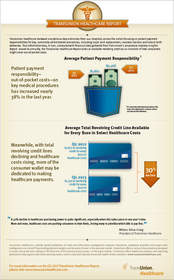CHICAGO, IL--(Marketwired - Nov 4, 2013) - Out-of-pocket costs for healthcare patients jumped more than 25% in the first half of 2013 and it's likely they will increase even more in the next year, according to the latest TransUnion Healthcare Report. While out-of-pocket costs (average patient payment responsibility) on key medical procedures continued to grow at a faster rate, the available revolving credit for consumers declined nearly $1,000 in the last year.
Average patient payment costs increased nearly 38% in the past year, from $1,862 in Q2 2012 to $2,568 in Q2 2013. Since the beginning of 2013, patient payment costs have risen more than $500 ($2,042 in Q4 2012). At the same time, the average consumer's total revolving credit line on products such as bank-issued credit cards, store credit cards and home equity loans has dropped from $34,855 in Q2 2012 to $33,884 in Q2 2013.
TransUnion Healthcare reviewed anonymous data estimates from 200 hospitals across the nation focusing on patient payment responsibilities for key, commonly administered procedures, including major joint replacement, cesarean section and natural birth deliveries. That information was, in turn, compared with financial data gathered from TransUnion's proprietary Industry Insights Report. Issued bi-annually, the TransUnion Healthcare Report looks at available revolving credit as an indicator on how consumers might cover out-of-pocket costs.
"The trend of growing consumer healthcare costs continued during the first six months of the year, and we suspect they may expand even more with the recent one-year grace period granted to some insurers for out-of-pocket expenses," said Milton Silva-Craig, president of TransUnion Healthcare. "As a result of this extension, patients expecting to pay no more than the Affordable Care Act's prescribed cap for out-of-pocket expenses may find that they owe both the maximum amount for hospital services and an additional maximum amount for prescription drugs. These added cost pressures will make it more difficult for patients to pay their bills, further burdening hospitals with the likelihood of more bad debt."
To better understand how increasing healthcare costs are impacting the consumer wallet, TransUnion Healthcare developed a proprietary ratio comparing available revolving credit to select healthcare costs. As of Q2 2013, the ratio of total revolving credit line to healthcare costs was 13.2 to 1. Thus, for every $100 in healthcare costs, consumers had $1,320 in revolving credit to potentially make those payments. For the same quarter last year, this ratio stood at 18.7 to 1, meaning consumers had $1,870 in revolving credit for every $100 in healthcare costs. "A 30% decline in healthcare purchasing power is quite significant, especially when this takes place in one year's time. More and more, healthcare costs are pushing the consumer to their financial limits where they may need to prioritize which bills to pay first," said Silva-Craig.
The TransUnion Healthcare Report found that subprime consumers are likely feeling the brunt of increased healthcare costs. For instance, the available revolving credit to healthcare costs ratio has dropped from 4.8 to 1 (Q2 2012) to 3.2 to 1 (Q2 2013), a 34% drop. Compared to the entire consumer credit population, subprime consumers have about one-quarter of the purchasing power for these select healthcare services.
"A good number of subprime consumers meet the criteria for charity care, which would lessen their healthcare costs, but we have found that many fall through the cracks for a myriad of reasons including not filling out the proper paperwork," said Silva-Craig. "While more hospitals are using electronic financial tools that assist them in providing proper financial assistance to those who most need it, this is still not a widely used practice."
On a positive note, consumers continue to better manage their revolving debt balances. Average revolving debt dropped for the seventh straight quarter to $11,943 in Q2 2013, down almost 6% from Q2 2012. Subprime consumers also saw their average revolving balances drop, declining 10% in the last year to $8,317 in Q2 2013.
While revolving debt balances have declined, patients are seeing healthcare cost increases across the board. The TransUnion Healthcare Report found that patients are facing average deductibles that have nearly doubled, jumping from $777 in Q2 2012 to $1,477 in Q2 2013. Average co-payments increased from $69 to $82 in that same timeframe.
Increased costs for the key healthcare procedures reviewed include a 53% rise in cesarean section birth deliveries from $1,456 (Q2 2012) to $2,224 (Q2 2013). Natural birth costs have increased 45% in that same time to $1,702 in Q2 2013. Major joint replacement costs increased to $3,068, 24% higher than in Q2 2012.
For more information on the TransUnion Healthcare Report, please visit www.transunioninsights.com/healthcare.
* Subprime is categorized as consumers with a VantageScore® credit score lower than 640 on a scale of 501-990.
TransUnion Healthcare
TransUnion Healthcare, a wholly owned subsidiary of credit and information management company TransUnion, empowers providers with Intelligence in an Instant® by providing data and analytics at the point of need. TransUnion offers a series of data solutions designed to provide greater ease of use, accuracy and transparency in the revenue cycle process thereby assisting providers in lowering their uncompensated care. www.transunionhealthcare.com
Contact Information:
Contact:
Dave Blumberg
TransUnion
312 985 3059
